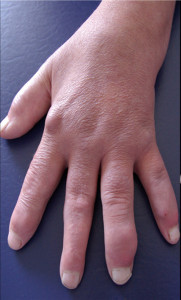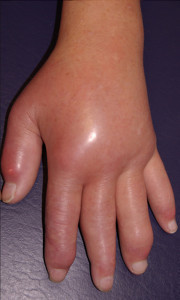Kamikaze cells stop inflammation

FAU researchers discover a new immune system mechanism which is effective against gout
The human body is able to use a sophisticated trick to free itself from inflammation. This was recently discovered by FAU researchers. They observed how immune cells self-destructed when attacking gout crystals to form a tight net around the inflamed area and restrict swelling.
Gout is a metabolic disease in which uric acid accumulates in the body and is deposited in joints and tissue in the form of minute needle-shaped crystals. The immune system tries to fight these crystals. The consequence of this is a severe attack of pain. Interestingly, an attack of gout subsides after a few days even when left untreated, although the uric acid crystals still bore into the tissue.
The causes and mechanisms involved in this self-healing process were unknown until now. FAU researchers have recently discovered that a group of white blood cells – the neutrophile granulocytes – plays a key role in this phenomenon. These phagocytes are the immune system’s first line of defence. ‘We have observed that these cells literally explode when they come across inflammation,’ explains Dr. Markus Hoffmann from the Department of Medicine 3 – Rheumatology and Immunology at Universitätsklinikum Erlangen (head of department: Prof. Dr. Georg Schett). Components of the cells such as DNA and protein then form tight nets in the tissue. The stronger the defensive reaction and the more granulocytes fight the inflammation, the tighter and more complex these nets become, covering more dangerous substances such as gout crystals. Messenger substances from the inflammation also become caught like fish in a net and are deactivated and broken down there. If they become large enough, the clotted nets are actually visible as tophi.

tophi are often left behind. (Image: FAU)

pain and swelling (Image: FAU)
During their investigations, the FAU researchers were also able to show that patients who cannot form these nets due to genetic deficiencies suffer from chronic inflammation in the affected tissue because inflammatory substances are able to spread freely. This knowledge of how the body is able to limit inflammation itself means there is hope for new therapeutic approaches. ‘We suspect that the immune system does not just restrict inflammation in this way in gout but also in other diseases where neutrophile granulocytes play a role, such as in cystic fibrosis – a severe lung disease in young people – or in systemic lupus erythematosus – an autoimmune disease which mainly affects young women,’ Dr. Markus Hoffmann explains.
Further information:
Dr. Markus Hoffmann
Phone: +49 9131 8539109
markus.hoffmann@uk-erlangen.de